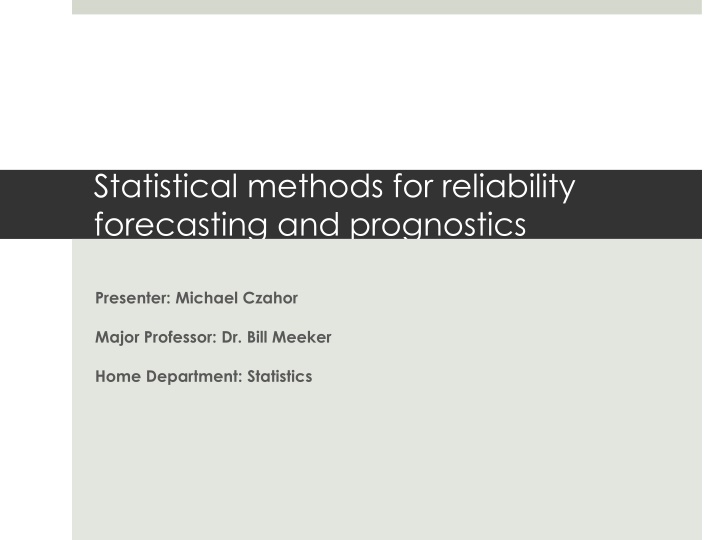
Reliability Forecasting and Prognostics Methods Presentation
Explore statistical methods for reliability forecasting and prognostics presented by Michael Czahor. Discover the motivation, background, research needs, challenges, failure modes, industry approaches, and Sandia's perspective on reliability. Learn about preventing unplanned maintenances using statistical analysis and delve into big data implications in the field.
Download Presentation

Please find below an Image/Link to download the presentation.
The content on the website is provided AS IS for your information and personal use only. It may not be sold, licensed, or shared on other websites without obtaining consent from the author. If you encounter any issues during the download, it is possible that the publisher has removed the file from their server.
You are allowed to download the files provided on this website for personal or commercial use, subject to the condition that they are used lawfully. All files are the property of their respective owners.
The content on the website is provided AS IS for your information and personal use only. It may not be sold, licensed, or shared on other websites without obtaining consent from the author.
E N D
Presentation Transcript
Statistical methods for reliability forecasting and prognostics Presenter: Michael Czahor Major Professor: Dr. Bill Meeker Home Department: Statistics
A Brief Background Drexel University-BMES Dept. Rowan University-Mathematics Statistical motivation (Dr. Lacke/Dr. Thayasivm) Alternative Energy Motivation Comcast Spectacor Statistician Intern (Senior Year)
Iowa State University IGERT Fellow *Funded through NSF* WESEP Student Home Department: Statistics Major Professor: Dr. William Meeker WESEP Faculty: PI: Dr. James D. McCalley For Co-PI refer to: WESEP Faculty
Goal Prevent unplanned maintenances with the use of statistical analysis
Todays Presentation Motivation for Research/Sample Study Needs and Challenges for Reliability Study Address the need to analyze field data Formally share my Research Idea Initial Analysis Concluding Remarks/Q&A
Part 1: Motivation For Research Hahn, Durstewitz, and Rohrig (2007) Study 98 Percent of Availability Design lifetime is expected to be around 20 years. Reliability: Number of failures per unit time Failures: Early(IM), Random, Wear-out (Degradation)
Big Data Big data refers to datasets whose size is beyond the ability of typical database software tools to capture, store, manage, and analyze. This definition is intentionally subjective and incorporates a moving definition of how big a dataset needs to be in order to be considered big data i.e., we don t define Big data in terms of being larger than a certain number of terabytes (thousands of gigabytes). We assume that, as technology advances over time, the size of datasets that qualify as big data will also increase. Also note that the definition can vary by sector, depending on what kinds of software tools are commonly available and what sizes of datasets are common in a particular industry. With those caveats, big data in many sectors today will range from a few dozen terabytes to multiple petabytes (thousands of terabytes).
Big Data for Wind Turbines Sensors/Smart Chips Use Rate System Load Vibrations Physical/Chemical Degradation Indicators of Imminent Failure
Reliability Field Data Maintenance Contracts/ Maintenance Reports Optimize cost of system operation Sensors Prognostics Information Systems System Health Monitoring (SHM) to predict system performance in the field
Applications Prevent in-service failures Prevent unplanned maintenance System Operating/Environmental will do better job
Main Research Topic Wind Turbines are producing a large amount of environmental field data that describe the loads being put on individual turbine components. This data will be used to model system lifetimes and hopefully draw strong conclusions in regard to maintenance needs for individual components within and among the turbine for nearby time intervals.
Example of Non-Parametric Analysis A Kaplan-Meier estimate is a completely non-parametric approach to estimating a survivor function. A survival function can be estimated by calculating the fraction of survivors at each failure time as in the following equation:
Relation to other WESEP Students Quantifying failure modes of design flaws in individual components. Relating environmental conditions to failure modes of individual components. General System Health Monitoring practices
Conclusion/Q&A Field data is being produced at as high of level as it has ever been. Sensing technology allows us to collect large amounts of data to be analyze (Big Data). Next Semester: Preliminary Survival code to analyze data (Non Parametric) A better understanding of each individual component Implement Statistics 533 Knowledge into next WESEP 594 presentation. Summer: DATA
References [1] Hahn, Berthold, Michael Durstewitz, and Kurt Rohrig. "Reliability of Wind Turbines." Institut F r Solare Energieversorgungstechnik (ISET). N.p., 2007. Web. [2] Kahrobaee, Salman, and Sohrab Asgarpoor. "Risk-Based Failure Mode and Effect Analysis for Wind Turbines (RB- FMEA). Digital Commons. University of Nebraska-Lincoln, 1 Jan. 2011. Web. [3] Meeker, William Q., Dr., and Yili Hong, Dr. Reliability Meets Big Data: Opportunities and Challenges. N.p., 23 June 2013. [4] Sandia Wind Reliability Workshop http://windworkshops.sandia.gov/?page_id=353 [5] Walters, Stephen J. "What Is a Cox Model?" School of Health and Related Research (ScHARR). Hayward Medical Communications, 2001. Web.
